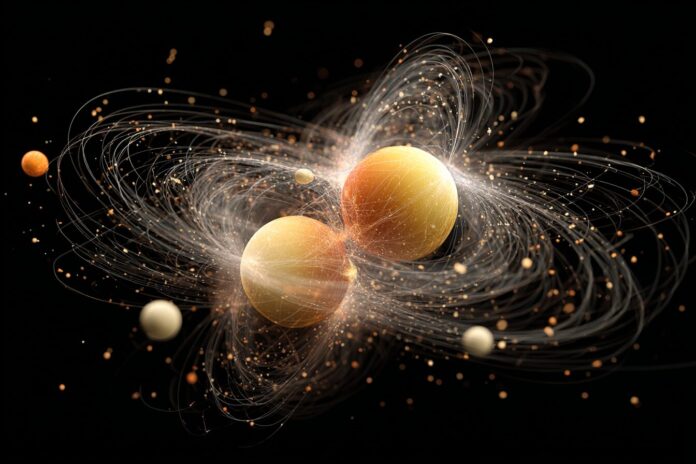Unlocking the Universe’s Hidden Secrets
Every so often, a scientific breakthrough challenges our conventional understanding of the universe. Recently, physicists reported tantalizing evidence of a new, fifth fundamental force lurking inside atoms. This discovery, if confirmed, has the potential to redefine our understanding of cosmic dynamics and the fundamental interactions that govern nature.
Most importantly, the prospect of a hidden force raises new questions about the fabric of reality. Because the Standard Model has long provided the bedrock for our understanding of particle physics, the indication of an undiscovered force could open pathways to solve enduring mysteries such as dark matter, dark energy, and even the inconsistencies in gravitational behavior observed on cosmic scales.
Revisiting the Four Known Fundamental Forces
Before we delve deeper into the possibility of a new force, it is crucial to revisit the four recognized forces that shape our physical reality:
The first is Gravity, which attracts masses across vast cosmic distances; the second is the Electromagnetic Force, responsible for phenomena such as electricity, magnetism, and light; third, the Strong Nuclear Force binds protons and neutrons within the atomic nucleus; and finally, the Weak Nuclear Force governs nuclear decay processes. These interactions have been meticulously verified over decades, providing the foundation for the Standard Model.
Because scientists have long suspected that these forces might not paint the complete picture, the search for additional interactions remains a topic of vivid research and debate within the physics community.
The Tantalizing Clues: Muon Mysteries and Magnetic Wobbles
Recent experimental observations have provided intriguing hints through studies of the muon — a heavier cousin of the electron. The Muon g-2 experiment at Fermilab observed an unexpected wobble in muon behavior when subjected to magnetic fields. This deviation from the Standard Model’s predictions strongly suggests the influence of previously unknown subatomic phenomena.
Furthermore, detailed data analysis, such as Alan Turing’s techniques showcased in recent discussions on the subject (see this video), has provided additional context that supports the existence of new particles or interactions. Therefore, these results urge the physics community to contemplate revised theories that integrate a fifth force into existing frameworks.
Decoding the Fifth Force: Theories and Possibilities
If the fifth force is confirmed, it would be revolutionary. Because it could provide insights into why gravity behaves differently on both microscopic and cosmic scales, such a force might act as a bridge between classical physics and quantum mechanics. Researchers have proposed that this additional force may be mediated by a new force carrier—a particle interacting under extremely specific conditions, thus remaining elusive in previous observations.
Besides that, understanding the nature of this force could clarify the role of dark energy in accelerating the universe’s expansion. Some theories, as discussed in Universe Today, propose that the fifth force may connect phenomena that both hinder and propel cosmic evolution. This could lead to a unified theory where quantum mechanics and relativistic physics coexist in harmony.
Experimental Hurdles and the Road to Verification
Scientific progress is inherently cautious. Past claims of new forces were sometimes retracted when later experiments indicated errors in methodology. For instance, earlier experimental anomalies were eventually attributed to design flaws. Most importantly, such experiences underscore the need for meticulous verification in experimental setups. Researchers emphasize that any claim regarding a fifth force must be rigorously vetted using updated and refined methodologies.
Because independent experiments and cross-validation approaches are being implemented worldwide, critical questions continue to drive research in this domain. Advanced high-precision detectors and sophisticated data analysis techniques are now in use, making it easier to differentiate between genuine new physics and artifacts of experimental error. In this light, the corrections discussed by IO+ in their comprehensive analysis (read more here) have been influential in shaping current research protocols.
Implications for the Future of Physics
The discovery of a fifth force would represent one of the most transformative shifts in physics since the establishment of the Standard Model. This addition may drive the development of new theoretical frameworks that reconcile quantum mechanics with gravitational theory. Because of this possibility, textbooks could be rewritten and future research may venture into unexplored territories of science.
Moreover, confirming a new force could inspire technological advances that harness these fresh insights. As highlighted by Popular Mechanics, experimental evidence from asteroid trajectories and other cosmic phenomena may eventually lead to innovations that benefit various scientific and industrial fields. Therefore, embracing this potential paradigm shift can lead to monumental progress in our understanding of the universe.
Looking Ahead: A New Era of Discovery?
The collaborative efforts of scientists worldwide, ranging from particle collider experiments to astronomical observations, indicate that we are at the brink of a revolutionary era in physics. Researchers remain hopeful that upcoming data will either solidify the existence of the fifth force or guide scientists to new theories entirely.
Besides that, the pursuit of confirming this force illustrates the enduring human spirit of inquiry. As more data becomes available, the boundaries of our known universe may extend beyond current limits, opening fresh chapters in scientific literature, as detailed by both ScienceAlert and other reputable sources.
Further Reading and References
For readers interested in exploring this topic further, several reputable sources provide additional insights and detailed analyses on the potential discovery of a fifth force. These include:
- ScienceAlert – A Fifth Force of Nature May Have Been Discovered Inside Atoms
- Universe Today – Is There a Fifth Force of Nature?
- IO+ – A Fifth Force of Nature? How an Experimental Flaw Led Us Astray
- Popular Mechanics – Scientists Are Getting Closer to Finding Evidence of the Fifth Force
- YouTube – Alan Turing’s Data Analysis on the Fifth Force
Because these readings span from theoretical discussions to experimental evidence, they offer a comprehensive overview that augments our understanding of potential new frontiers in physics.



